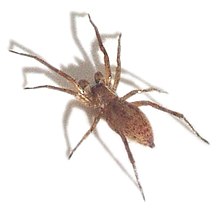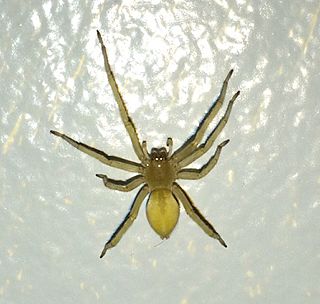
Cheiracanthium inclusum, alternately known as the black-footed yellow sac spider or the American yellow sac spider, was formerly classified as a true sac spider, and then placed in the family Miturgidae, but now belongs to family Cheiracanthiidae. It is a rather small pale yellow species that is indigenous to the Americas. It is often found living in the foliage of forests and gardens but also can inhabit human homes. Despite common beliefs of necrosis, Cheiracanthium bites cause only localized swelling. C. inclusum is closely related to Cheiracanthium mildei, an introduced species native to Europe which is similar in appearance and natural history and can also be found in North American homes.

Norman Ira Platnick was an American biological systematist and arachnologist. At the time of his death, he was a professor emeritus of the Richard Gilder Graduate School and Peter J. Solomon Family Curator Emeritus of the invertebrate zoology department of the American Museum of Natural History. A 1973 Ph.D. recipient at Harvard University, Platnick described over 1,800 species of spiders from around the world, making him the second most prolific spider taxonomist in history, behind only Eugène Simon. Until 2014 he was also the maintainer of the World Spider Catalog, a website formerly hosted by the AMNH which tracks the arachnology literature, and attempts to maintain a comprehensive list, sorted taxonomically, of every species of spider which has been formally described. In 2007 he received the International Society of Arachnology's Bonnet award, named for Pierre Bonnet, in recognition of his work on the catalog.

A leaf miner is any one of numerous species of insects in which the larval stage lives in, and eats, the leaf tissue of plants. The vast majority of leaf-mining insects are moths (Lepidoptera), sawflies, and flies (Diptera). Some beetles also exhibit this behavior.

The Dionycha are a clade of spiders (Araneomorphae:Entelegynae), characterized by the possession of two tarsal claws with tufts of hairs (setae) beside them, which produce strong adhesion, enabling some species to climb glass. The circumscription of the group has varied widely; a 2021 analysis resulted in about 20 families, including Salticidae, Gnaphosidae, and Clubionidae.
The Dictynoidea or dictynoids are a group of araneomorph spiders that have been treated as a superfamily. The composition of the group has varied. Phylogenetic studies in the 21st century have failed to confirm the monophyly of the dictynoids as originally defined.
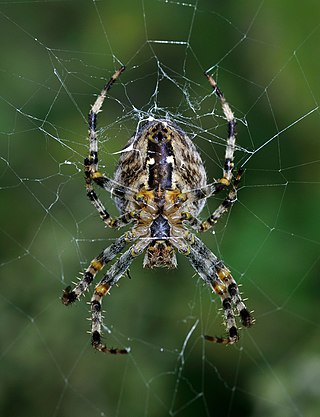
The Entelegynae or entelegynes are a subgroup of araneomorph spiders, the largest of the two main groups into which the araneomorphs were traditionally divided. Females have a genital plate (epigynum) and a "flow through" fertilization system; males have complex palpal bulbs. Molecular phylogenetic studies have supported the monophyly of Entelegynae.
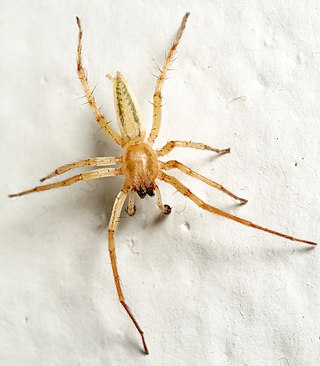
Hibana is a genus of anyphaenid sac spiders first described by Antônio Brescovit in 1991. It is found from the United States to Brazil, including the West Indies. It includes North America's yellow ghost spider, formerly categorized as Aysha velox.
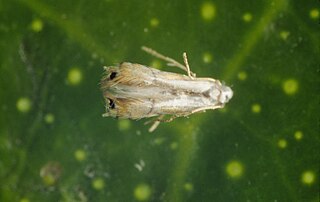
The citrus leafminer is a moth of the family Gracillariidae. It is also known as CLM in agriculture. It was described by Henry Tibbats Stainton from India in 1856. It was first found in Florida, United States, in 1993, but is now found all over the world, including Argentina, Australia, Brazil, China, Corsica, Costa Rica, Cuba, India, Israel, Madeira, Malaysia, Mauritius, Mexico, the Philippines, South Africa, Spain, Sri Lanka and other parts of the United States.
Antônio Domingos Brescovit is a Brazilian arachnologist. His first name, Antônio may also be spelt António. He develops academic activities at the 'arthropodae laboratorium' at the Butantan Institute, and he is a specialist in Neotropical Arachnida.
Araiya is a genus of South American anyphaenid sac spiders first described by M. J. Ramírez in 2003.As of April 2019 it contains only two species.

Axyracrus is a genus of South American anyphaenid sac spiders containing the single species, Axyracrus elegans. It was first described by Eugène Simon in 1884, and has only been found in Chile and Argentina. It is a senior synonym of "Schiapellia"
Gamakia is a genus of South American anyphaenid sac spiders containing the single species, Gamakia hirsuta. It was first described by M. J. Ramírez in 2003, and has only been found in Chile.
Gayennoides is a genus of South American anyphaenid sac spiders first described by M. J. Ramírez in 2003. As of April 2019 it contains only two species, both found in Chile.
Malenella is a genus of South American tangled nest spiders containing the single species, Malenella nana. It was first described by M. J. Ramírez in 1995, and has only been found in Chile. This genus was named in honour of María Elena Galiano.
Negayan is a genus of South American anyphaenid sac spiders first described by M. J. Ramírez in 2003.
Oxysoma is a genus of South American anyphaenid sac spiders first described by H. Nicolet in 1849.
Selknamia is a genus of South American anyphaenid sac spiders containing the single species, Selknamia minima. It was first described by M. J. Ramírez in 2003, and has only been found in Chile and Argentina.

Arachosia is a genus of anyphaenid sac spiders that was first described by Octavius Pickard-Cambridge in 1882.
Josa is a genus of South American anyphaenid sac spiders first described by Eugen von Keyserling in 1891. It is a senior synonym of "Gayenella", "Haptisus", "Olbophthalmus", and "Pelayo".
Sinophaena is a small genus of east Asian anyphaenid sac spiders. It was first described by Y. J. Lin, Yuri M. Marusik and C. X. Gao in 2021, and it has only been found in China. As of November 2021 it contains only two species: S. bivalva and S. xiweni.
